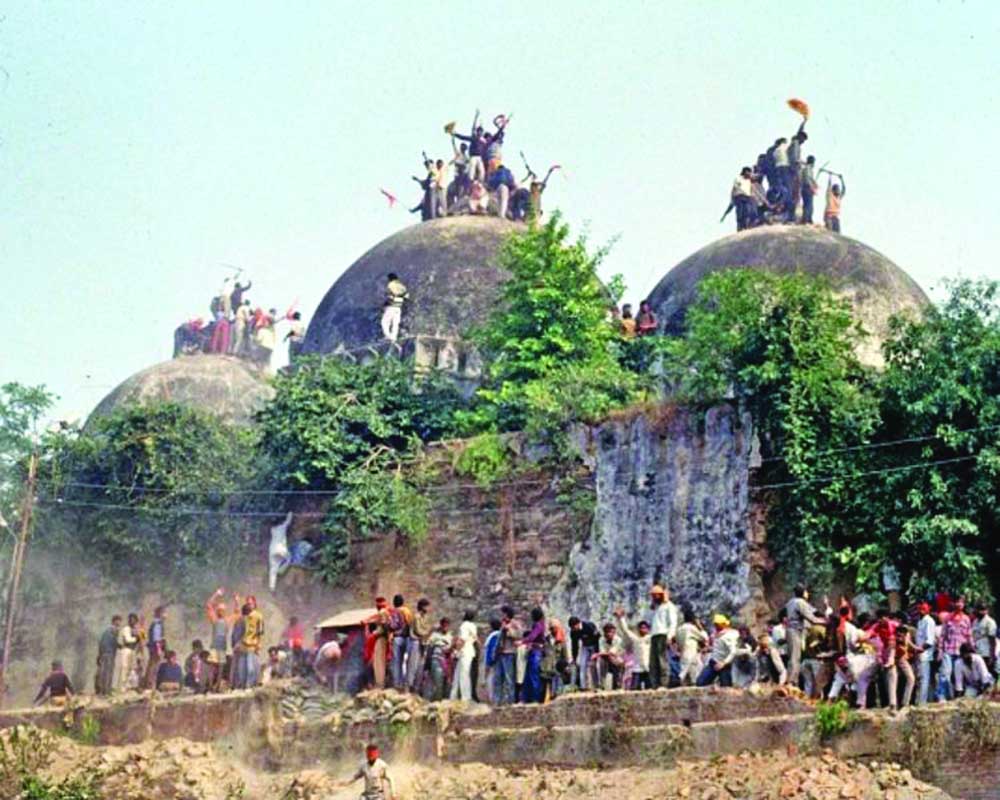The Supreme Court’s ruling would have legal, political and religious ramifications. Though the apex court’s order might put a lid on the legal aspect, its impact on politics and communal harmony will be equally significant
Ayodhya is getting ready to face the impact of the Supreme Court (SC) ruling on the Ram janmabhoomi-Babri Masjid title suit, next month. The verdict is expected to put a lid on the dispute between the two communities on the right of ownership of the site.
A violent mob of Karsevaks and prominent politicians had pulled down the mosque adjacent to the Ram temple in Ayodhya on December 6, 1992, which has tested the communal fabric of the country since then. The Hindus — represented by seven parties — have argued in the apex court that there was a temple dedicated to the birthplace of Lord Ram before the Babri Masjid was erected during medieval times. The verdict is likely to be delivered before November 17, by which time the present Chief Justice of India Ranjan Gogoi will be retiring.
The BJP leaders are upbeat and hoping for a favourable ruling. The party is happy that their “Mandir wahin banayenge (we will construct the temple on that spot)” slogan could at last become a reality, after a wait of nearly three decades.
Local BJP leaders claim that over 65 per cent of the stone craving work for the proposed temple has been completed and a lot of Karsevaks have volunteered to work for its construction. According to BJP MP Sakshi Maharaj, if the verdict goes in favour of the Hindus, Prime Minister Narendra Modi could lay the foundation stone on December 6.
Uttar Pradesh (UP) Chief Minister Yogi Adityanath has also said that he is hopeful of a favourable ruling. He has already prepared the State administration to face a post-verdict scenario. The Faizabad District has been renamed as Ayodhya, which is being developed as a tourist attraction with wider roads, spruced up ghats and refurbished heritage temples.
The Ayodhya verdict would have legal, political and religious ramifications. Though the apex court’s order might put a lid on the legal aspect, its impact on politics and communal harmony will be equally significant.
It is likely that the two sides might accept the SC’s judgment. Muslim religious scholars and leaders have also said that parties on both sides of the dispute should accept the verdict, whatever it may be.
It will be a big gain for the BJP, as the party’s political and electoral fortunes in the past three decades owe their rise to it, as the BJP began its campaign for the Ram temple in the ’90s. The razing of the Babri Masjid in 1992 was a turning point in the history of the BJP and its Hindutva politics. In fact Narendra Modi, who was a senior Gujarat leader at that time, had a role to play in BJP stalwart LK Advani’s Ram rath yatra, which began from Somnath in Gujarat to Ayodhya in 1990. However, the yatra did not culminate in Ayodhya as planned, as Advani was arrested.
The Babri Masjid demolition not only changed the political narrative of the country but it also helped the BJP establish itself in national politics.
Post the Babri Masjid demolition, the BJP acquired a national identity and stature. The party, which was known as a Bania–Brahmin party and had a strong presence only in the Hindi belt, has expanded as a pan-national party now, replacing the grand old party, the Congress.
The Ayodhya agenda has been a recurring theme, to which the Sangh Parivar and its affiliates, most importantly the BJP, have returned to again and again. The party has been consistently talking about building the Ram temple and had included it in its poll manifesto since 1996.
However, after the demolition, Advani had said that “the agitation is not just for constructing a temple, but to propagate Hindutva’s foundational idea — cultural nationalism.”
Other political parties, including the Congress, Samajwadi Party (SP), the Bahujan Samaj Party (BSP) and the Rashtriya Janata Dal (RJD) have been treading on the issue very cautiously.
Seeing the phenomenal rise of the BJP, the Congress has also been trying to play soft-Hindutva politics in recent times, with party leaders like Rahul Gandhi visiting temples before elections. The SP, BSP, RJD and other parties relevant in the ’90s have lost their sheen now.
The BJP’s future agenda depends on how it plays its Hindutva card. At present, the party would primarily like to consolidate its base all over the country. It has to expand in the North-East and the South and it is also planning to expand in West Bengal, Andhra Pradesh and Tamil Nadu. Moreover, the economic agenda needs priority as it is slipping beyond its control. Creation of jobs and boosting the economy needs immediate attention. It is easier said than done when the global economy is also facing a slowdown.
The saffron party’s next agenda is likely to be Pakistan Occupied Kashmir (PoK). In fact, BJP chief Amit Shah and the Minister for External Affairs S Jaishankar have gone public on reclaiming the PoK after the revocation of Article 370. But there is enough time for this until the next elections. Of course, one week is said to be long time in politics and five years are a very, very long time and there could be other issues, which may come up.
(The writer is a senior journalist)


























